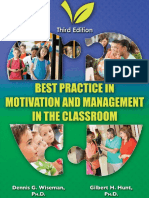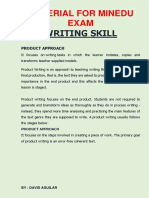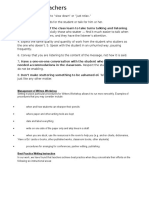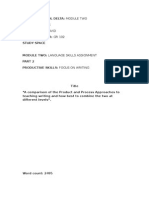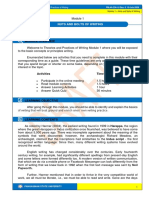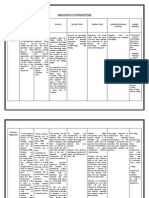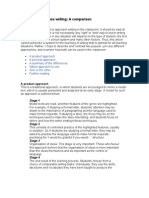Principles and Techniques in Teaching Writing
Principles and Techniques in Teaching Writing
Uploaded by
Shinisri EdogawaCopyright:
Available Formats
Principles and Techniques in Teaching Writing
Principles and Techniques in Teaching Writing
Uploaded by
Shinisri EdogawaCopyright
Available Formats
Share this document
Did you find this document useful?
Is this content inappropriate?
Copyright:
Available Formats
Principles and Techniques in Teaching Writing
Principles and Techniques in Teaching Writing
Uploaded by
Shinisri EdogawaCopyright:
Available Formats
PRINCIPLES AND TECHNIQUES IN TEACHING WRITING
ENRICO G. GOMEZ T-1, Orion Elementary School Friday, 21 October 2011 03:25 WRITING is communication. It can reach across space and time to instruct, to entertain and to touch others. It is a powerful way of sharing ideas and feelings. To achieve the best results, teacher should be guided by the fundamental principle of teaching writing which include the following: 1. 2. 3. 4. Writing literacy starts in the early years of child development. Writing is a creative act. Writing experiences should be child centered. Reading and writing like speaking and listening are separable process.
The process-oriented approach views writing as a creative process. Its processes are: a. b. c. Prewriting Writing Post writing
In prewriting it includes the setting of purposes, determining the audience, selecting/ordering information and gene the drafting and composing. Revising the draft and rewriting, editing and publishing are the last things to do in pos There are some techniques in teaching writing such as: Brainstorming Independently or in groups students generate as many ideas as possible from a given topics. Discussion Students talk about an assignment as they debate ideas to clarify thoughts. Creative Thinking Students try to look at usual subjects in unusual ways. Clustering Method of visually presenting the results of a discussion session. Cubing A swift or quick consideration of a subject from 6 point of view. Teachers can make writing a really fun activity to do for the students by applying these techniques.
Home Managed by Municipal Information Technology Department. All rights reserved.
http://www.orionbataan.com/component/content/article/68-education/589-principles-and-techniquesin-teaching-writing.html
Go back to:
Writing at Dartmouth
Online Writing Materials
Materials for Writing Tutors
OUR PEDAGOGY
The process approach to teaching writing
The Process Approach to Teaching Writing
On this page:
Defining Process Pedagogy Entering a Writer's Process Moving from Writer-Based to Reader-Based Prose
DEFINING PROCESS PEDAGOGY Think for a moment back to your high school and junior high school days. How were you taught to write? Were you asked to write about things that mattered to you? A favorite time of day? A moment rescued from your childhood? When you were given a book to write about, were you instructed in how to brainstorm until you found a topic that interested you? When you were confronted with a controversial issue - capital punishment, for instance - were you required to work with a group of your peers, to converse and to collaborate until you could together draft a paper that represented the views of all present? Were you instructed in how to organize your ideas? Were you
expected to revise your papers? Did you meet with the teacher or with your peers to talk about how you expressed yourself, as well as what you were saying? If you can answer "yes" to many of these questions, chances are you were taught to write according to the principles of process pedagogy. The most important principle of process pedagogy is that writing is the result of a very complex, highly individualized process. Before process pedagogy, writing classes generally ignored the writing process. Teachers assigned papers, graded them, and then handed them back. They attended to the product - its clarity, originality, and correctness - but they did not attend to the writing process. Nor did they attend to the writers themselves. The process theorists of the sixties and seventies took issue with this approach to teaching writing. After all, well-written essays don't fall from the sky. Rather, they are the result of a long, laborious, intensely personal process in which writers address several questions, ranging from What do I write about? to Who is my audience? to How do I structure my essay? to What sort of language and voice should I use? Process theorists believe that writing can be understood as the culmination of several steps in a complicated process. Furthermore, they feel that these steps - which include prewriting, writing, rewriting, and all their attendant strategies - can be talked about and modeled. In short, writing-as-a-process can be taught. At the Composition Center, we embrace the process approach to teaching writing first because this approach tells us that writing is teachable. But just as important is that process pedagogy emphasizes the usefulness of dialogue as a teaching technique. Process pedagogy challenges the traditional, authoritative models of teaching, in which professors (who know everything) talk "at" students (who know very little). Instead, process pedagogy empowers students by getting them to talk about their writing at every step of the writing process. It is this "talk" that you will be engaged in as tutors and writing assistants. ENTERING A WRITER'S PROCESS Entering a writer's process can be a terrifying, trying, exhilarating ordeal. Despite the frustrations that you are bound to encounter along the way, you'll come to love the
experience of sitting down with a writer, bending your heads over a paper, and wrestling an idea into language. Still, there are some things to think about as you step with a writer into her process.
First, where is the writer in her writing process? Is she writing her way towards her real subject? Has she found a subject and is searching for a structure? Or is she looking for ways to make her paragraphs work? Second, where can you enter the writer's process? Do you want to discuss the writer's choice of topic? Her thesis sentence? Her essay's structure? Its style? These decisions must be made quickly (if you are a tutor) and wisely (no matter which position you've been assigned). Where you enter the writer's process determines what you can do in the hour or so that you will devote to the paper.
Third, how do you enter the writer's process? Entering a writer's process is a delicate matter. You must understand how vulnerable the writer is to your criticisms. Try to think of ways to praise the writer before you begin your critique of her thinking or her prose. If you are a tutor, think about your body language. If you are a writing assistant, be careful about your tone. (Be patient: we have more elaborate advice, specific to tutors and writing assistants,elsewhere in this site.)
MOVING FROM WRITER-BASED TO READER-BASED PROSE Virtually all current composition theorists make a distinction between process-oriented and product-oriented writing. James McCrimmon sees it as the difference between writing as a way of knowing (process) and writing as a way of telling (product). Donald Murray sees it as the difference between internal and external revision (revising in order to clarify meaning for oneself vs. revising in order to clarify meaning for the reader). Linda Flower sees it as the difference between writer-based and reader-based prose. Though these theorists differ in their definitions of the distinction between process- and product-oriented writing, there is one important point upon which they all agree: good product depends on good process. But at some point in the writing process, writers must turn their attention from the writing process to the written product. They must transform writer-based prose into
reader-based prose. To do this, they must be ready to revise, paying close attention to their prose and to the effect it may be having on their audience. Often it's precisely at this point in the process that a writer will come to you for help. He has a draft completed, his argument seems logical and even persuasive, but he wants a second opinion. You read the essay and have some trouble following his line of reasoning. You point to a paragraph that is particularly confusing, and you ask what the writer is trying to say. He responds, "But it's all right there!" and goes on to summarize a point that he clearly hasn't made. What's happened? The writer's point is so firmly entrenched in his mind that he really believes that it's "in" the essay. You show him that it's not. You've just given him a lesson in the difference between writer-based and reader-based prose. In moving student writers from writer-based to reader-based prose, we must show them how readers experience their work. We must focus on the product in front of us and the effect that it has on us as readers. Is a sentence vague? A paragraph jumbled? A word choice not quite on the mark? In talking with writers, we can share our reading responses with them, and so point them to what is and is not effective about their work. We can show them how to improve the impression that they make on readers by helping them to craft sentences and paragraphs that are clear, concise, and easy to follow.
Written by Karen Gocsik Last modified: Tuesday, 12-Jul-2005 11:25:55 EDT Copyright 2004 Dartmouth College www.dartmouth.edu/~writing/materials/tutor/pedagogy/process.shtml
http://www.dartmouth.edu/~writing/materials/tutor/pedagogy/process.shtml
You might also like
- Creative Writing: A Curriculum For Secondary Students...Document104 pagesCreative Writing: A Curriculum For Secondary Students...Chandra Friend Montoya100% (2)
- Dennis G. Wiseman, Gilbert H. Hunt-Best Practice in Motivation and Management in The Classroom-Charles C Thomas Pub LTD (2013) PDFDocument345 pagesDennis G. Wiseman, Gilbert H. Hunt-Best Practice in Motivation and Management in The Classroom-Charles C Thomas Pub LTD (2013) PDFShinisri Edogawa67% (3)
- The Writing InstructionDocument4 pagesThe Writing InstructionQuennieNo ratings yet
- The Failure in Trnslating HumorDocument12 pagesThe Failure in Trnslating HumorShinisri EdogawaNo ratings yet
- The Nature of Writing Process in The English LessonDocument26 pagesThe Nature of Writing Process in The English LessonErne FlorNo ratings yet
- Writing SkillDocument15 pagesWriting SkillHelen Salazar SagasteguiNo ratings yet
- Informed Arguments A Guide To Writing and ResearchDocument198 pagesInformed Arguments A Guide To Writing and ResearchCheryl100% (1)
- Teaching Writing in Interactive EnglishDocument29 pagesTeaching Writing in Interactive EnglishjhoeyaxNo ratings yet
- Approaches To Process Writing - Teachingenglish - Org.ukDocument4 pagesApproaches To Process Writing - Teachingenglish - Org.ukciorapelaNo ratings yet
- The Writing ProcessDocument37 pagesThe Writing ProcessScribdTranslationsNo ratings yet
- WritingDocument3 pagesWritingعماد عبد السلامNo ratings yet
- Types of EssayDocument6 pagesTypes of Essaynour edhohaNo ratings yet
- What Is Process WritingDocument18 pagesWhat Is Process WritingFARMAN ULLAHNo ratings yet
- Module 3Document24 pagesModule 3Jessalyn JimenezNo ratings yet
- Product and Process WritingDocument5 pagesProduct and Process WritingAmna iqbalNo ratings yet
- Process-Writing - A Strategic Approach To Text ProductionDocument4 pagesProcess-Writing - A Strategic Approach To Text ProductionLidia FloresNo ratings yet
- CELTA Assignments' Writing TechniquesDocument6 pagesCELTA Assignments' Writing TechniquesMohamed AgrteneNo ratings yet
- Insert Creative Title Here: A Discussion On Creativity Within The Writing ProcessDocument12 pagesInsert Creative Title Here: A Discussion On Creativity Within The Writing ProcessElyse KuntzNo ratings yet
- The Process Approach To Writing PDFDocument4 pagesThe Process Approach To Writing PDFracard1529100% (1)
- Slo EssayDocument11 pagesSlo Essayapi-510176581No ratings yet
- Project 2 BrainstormDocument3 pagesProject 2 Brainstormapi-655385465No ratings yet
- Teaching of WritingDocument10 pagesTeaching of WritingEllaine GraceNo ratings yet
- Module 14 Teaching WritingDocument12 pagesModule 14 Teaching WritingJana VenterNo ratings yet
- 3 Approaches For WritingDocument4 pages3 Approaches For Writingkamran imtiazNo ratings yet
- Writing PresentationDocument33 pagesWriting Presentationشادي صابرNo ratings yet
- Concerns and Strategies in Pre-Writing, Drafting, Revising, Editing, Proofreading, and PublishingDocument5 pagesConcerns and Strategies in Pre-Writing, Drafting, Revising, Editing, Proofreading, and Publishingsalditoskriiusy0% (1)
- Planning A Writing LessonDocument9 pagesPlanning A Writing LessonZaleha AzizNo ratings yet
- Error Analysis On Essay Writing OrganizationDocument11 pagesError Analysis On Essay Writing OrganizationIrene FungNo ratings yet
- ETW431 ARTICLE Q3 Become Competent Writer Sep2015Document12 pagesETW431 ARTICLE Q3 Become Competent Writer Sep2015Louis SpencerNo ratings yet
- Geib Fall 2016 SyllabusDocument7 pagesGeib Fall 2016 SyllabusElizabeth GeibNo ratings yet
- 8 Tips For Teachers: Needed Accommodations in The Classroom. Respect The Student's Needs, ButDocument6 pages8 Tips For Teachers: Needed Accommodations in The Classroom. Respect The Student's Needs, ButRishabh Madhu SharanNo ratings yet
- Writing Project 3Document6 pagesWriting Project 3api-317104616No ratings yet
- 2015 Complete Gumi Writing BookDocument35 pages2015 Complete Gumi Writing BookNUTCHA WEAWSIANGNo ratings yet
- Teaching121chapter of A BookDocument30 pagesTeaching121chapter of A BookBarbara BaranyaiNo ratings yet
- A Comparison of The Product and Process Approaches To Teaching Writing and How Best To Combine The Two at Different Levels.Document20 pagesA Comparison of The Product and Process Approaches To Teaching Writing and How Best To Combine The Two at Different Levels.Priya Darshini MuruganNo ratings yet
- Writing Processes-Final JMWDocument6 pagesWriting Processes-Final JMWapi-313623377No ratings yet
- Writing Product Vs ProcessDocument5 pagesWriting Product Vs Processboxer jadiNo ratings yet
- SG - 1 Theories and Practices of WritingDocument24 pagesSG - 1 Theories and Practices of Writingavy mariel alcantaraNo ratings yet
- JournalDocument5 pagesJournalapi-673061347No ratings yet
- InventionexcersiseDocument4 pagesInventionexcersiseapi-317906787No ratings yet
- Approaches To Teaching WritingDocument4 pagesApproaches To Teaching WritingsulaimrahmanNo ratings yet
- Expanding The Horizons: Rhetorical KnowledgeDocument5 pagesExpanding The Horizons: Rhetorical Knowledgemj_amazinggNo ratings yet
- Product and Process WritingDocument4 pagesProduct and Process WritingStella María Caramuti PiccaNo ratings yet
- Writing ProjectDocument5 pagesWriting ProjectSteven CorderoNo ratings yet
- NAME: Technology and Influencing People, Environment and Citizen CoexistenceDocument12 pagesNAME: Technology and Influencing People, Environment and Citizen CoexistenceDiana Patricia Alcala PerezNo ratings yet
- SyllabusDocument7 pagesSyllabusapi-339976453No ratings yet
- Communicative Language TeachingDocument8 pagesCommunicative Language TeachingNgoc YenNo ratings yet
- T A MacroskillDocument36 pagesT A Macroskillengkeechangrapen12No ratings yet
- Writing Process Group 1Document11 pagesWriting Process Group 1Ivan MaulanaNo ratings yet
- Reflective Essay On Literature ReviewDocument5 pagesReflective Essay On Literature Reviewgjosukwgf100% (1)
- Teaching WritingDocument63 pagesTeaching WritingHoney AniNo ratings yet
- Writing Aloud: An Effective and Efficient Way To Model The Writing ProcessDocument9 pagesWriting Aloud: An Effective and Efficient Way To Model The Writing ProcessPOMPEIU FRIASNo ratings yet
- Planning A Writing Lesson - TeachingEnglish - British Council - BBCDocument4 pagesPlanning A Writing Lesson - TeachingEnglish - British Council - BBCHanif MohammadNo ratings yet
- SoapstoneDocument2 pagesSoapstonejrogenski9000No ratings yet
- Feedback in The WritingDocument11 pagesFeedback in The WritingTina PoštićNo ratings yet
- AP SyllabusDocument3 pagesAP SyllabusMichael EdlerNo ratings yet
- The Writing Process and Creative Writing PDFDocument67 pagesThe Writing Process and Creative Writing PDFMar CrespoNo ratings yet
- A Teacher Guide To Publication 07 07 13Document9 pagesA Teacher Guide To Publication 07 07 13api-194333853No ratings yet
- module 5_PHI-1300-jul16Document11 pagesmodule 5_PHI-1300-jul16vvarkey75No ratings yet
- Writing for Understanding: Using Backwards Design to Help All Students Write EffectivelyFrom EverandWriting for Understanding: Using Backwards Design to Help All Students Write EffectivelyNo ratings yet
- Research Instrument Blue Print Appendix 1 Research Questions Purposes Technique Data SourcesDocument1 pageResearch Instrument Blue Print Appendix 1 Research Questions Purposes Technique Data SourcesShinisri EdogawaNo ratings yet
- Assessing The Academic English Needs of King Fahd Security College OfficersDocument5 pagesAssessing The Academic English Needs of King Fahd Security College OfficersShinisri EdogawaNo ratings yet
- Primary Grades Comprehension Pack - Hows The Weather PDFDocument14 pagesPrimary Grades Comprehension Pack - Hows The Weather PDFShinisri EdogawaNo ratings yet
- Pendidikan Bahasa Inggris Tentang Kumpulan Skripsi Pendidikan Bahasa InggrisDocument14 pagesPendidikan Bahasa Inggris Tentang Kumpulan Skripsi Pendidikan Bahasa InggrisShinisri EdogawaNo ratings yet
- Type of Scoring RubricDocument6 pagesType of Scoring RubricShinisri EdogawaNo ratings yet
- Analytical Paragraph RubricDocument1 pageAnalytical Paragraph RubricShinisri EdogawaNo ratings yet
- Principles and Techniques in Teaching WritingDocument5 pagesPrinciples and Techniques in Teaching WritingShinisri EdogawaNo ratings yet

